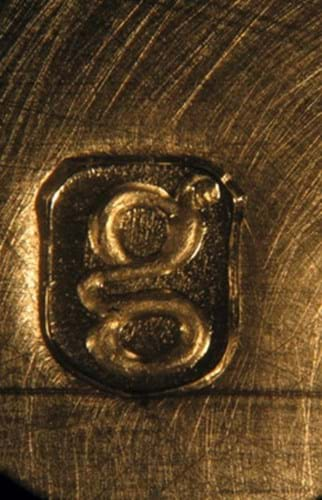
At Snaresbrook Crown Court in London on Thursday, September 28, Peter Ashley-Russell was sentenced to a total of three years' imprisonment for offences under the Forgery Act 2006, including four offences relating to the faking and forging of antique silver.
Evidence against the fraud was provided by the Metropolitan Police and the Antique Plate Committee (APC), the industry-recognised body established in 1939 that examines suspect silver items and advises Assay Office London on the authenticity of hallmarks and illegal alterations or additions.
The second Ashley-Russell case - he received a custodial sentence for similar activities in 1986 - has been described as the most significant involving hallmarking deception since the infamous Lyon and Twinam case of the late Victorian era.
Police were first alerted to the fakes in 2002 following the submission to the Antique Plate Committee of ten suspect pieces (five marrow scoops and five trefid spoons) from three sources - Stansted auctioneers Sworders, Lewes auctioneers Gorringes and a West Country dealer.
However, it was not until Spring 2007 that the Metropolitan Police's Specialist Crime Operations team, led by Detective Constable Tim Duffin, raided a property in Beckton, East London. In one bedroom they found a silversmith's workshop and seized a number of pieces of silver plus 55 fake punches that consisted of town marks, date letters and makers' marks all purporting to be from the late 17th to the early 18th centuries. Ashley-Russell, an ex-student at Taunton College of Art and an erstwhile printer with a knowledge of metal type, admitted making them.
After the police raid in 2007, the APC convened an extraordinary committee meeting, subjecting 150 pieces to a combination of objective scientific measurement methods, connoisseurship and the extensive records retained by The Worshipful Company of Goldsmiths.
All who have handled the material describe it as very convincing and the work of a professional forger. One spoon alone does not raise many questions: it is only when a group can be studied together that similarities in the engraving and marks cause suspicions to be aroused.
Some are thought to be Stuart period spoons with rubbed marks subsequently 'improved', while others were total fabrications. The raid on the house in East London uncovered forks in a number of stages of production, from a beaten ingot to others awaiting marks and finishing. The fraudulent activities also included the conversion of spoons to forks (to increase their value), while there were also two Georgian coffee pots awaiting modifications, including applied coats of arms and new marks.
Woolley & Wallis silver specialist Alex Butcher, a recognised expert on spoons and - importantly for the purposes of this case - not a full member of the APC, was called as an expert witness. While Ashley-Russell had admitted the offences at an earlier court appearance in April, he was disputing the potential market value of the items he had created.
In a so-called Newton hearing (one where the defendant has admitted guilt but disputes the facts of the case), Mr Butcher provided convincing evidence that Ashley-Russell's valuation of the 39 pieces at around £5000 should be increased at least fourfold.
The size of Ashley-Russell's fraud is not yet known, although it is possible it was on a larger scale than his endeavours in the 1980s that caused fissures through the spoon market.
While this prosecution was formed around 39 pieces, he is also known to have had an eBay account, regularly listing silver flatware. It is thought that more than 450 items were offered on eBay but - as the police wished to avoid a costly and time-consuming High Court appearance to obtain a production order that would have allowed them to look at eBay and PayPal accounts - they did not form part of the case. The whereabouts of much of this material sold online remains unknown.
Accordingly, the silver trade are keen for as much information to be made public as soon as possible. Petworth dealer Nicholas Shaw commented: "As a specialist dealer in spoons, I am grateful to the police and the APC for the work they have done on this case. Hopefully now this material can be quickly made available so that responsible dealers can familiarise themselves with Ashley-Russell's work."
Dr Robert Organ, deputy warden of Assay Office London, said discussions were taking place on how "a unique and invaluable educational resource" can be used to educate the trade on identification of spurious antique silver plate. An exhibition and a publication are planned although no time frame has been given.
However, following a request from ATG, the APC provided information on the 55 punches seized in the raid of Ashley-Russell's house. A list of 23 suspect maker's marks can be found here.
The Ashley-Russell fakes are believed to be one of several ongoing investigations into antique silver forgeries.
In July 2005, a single vendor tried to sell fake 18th and 19th century smallwork through several auction rooms in central and southwest England. Here the numbers were relatively small and the quality of the material - small collector's pieces including trefid, caddy and double-ended medicine spoons - deemed relatively poor.
Of more concern to the silver trade are pieces of suspect 'Georgian' hollowware, including what purported to be a George I Britannia Standard bowl and ewer that sold for £90,000 to S.J. Phillips at Duke's of Dorchester in 2002. It was later returned after it tested only as sterling.
The Assay Office advise anyone worried about a spoon they may have purchased to send it to the APC for checking. Telephone 020 7606 8971.
By Roland Arkell and Anne Crane
For a list of 23 suspect maker's marks on pieces identified as problematic by the APC click here.
For details of the Peter Ashley-Russell case in 1986 click here.
For details of the Lyon and Twinam case in 1898 click here.




